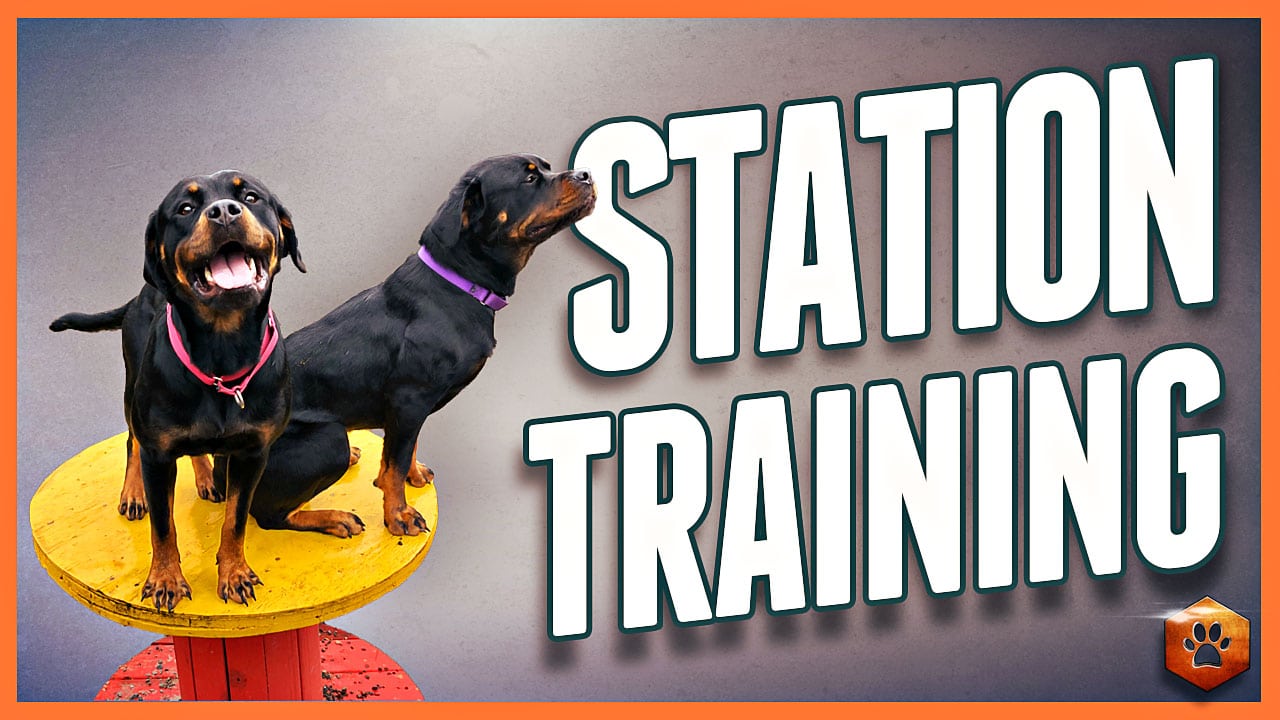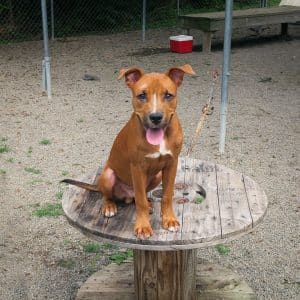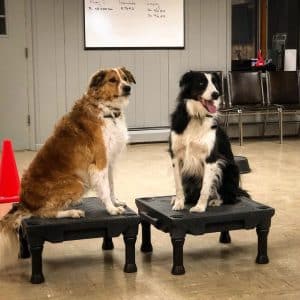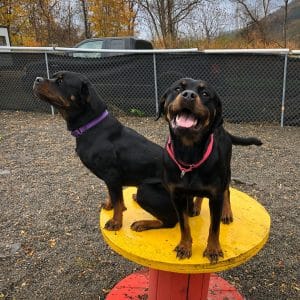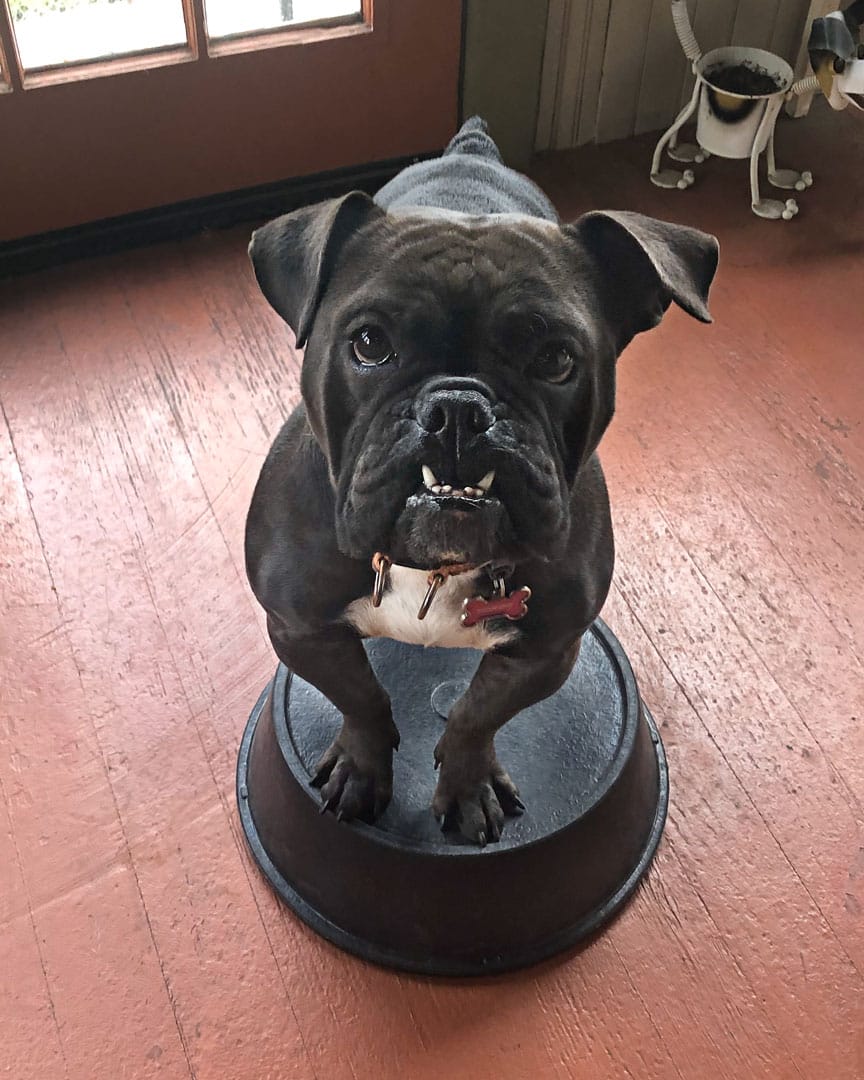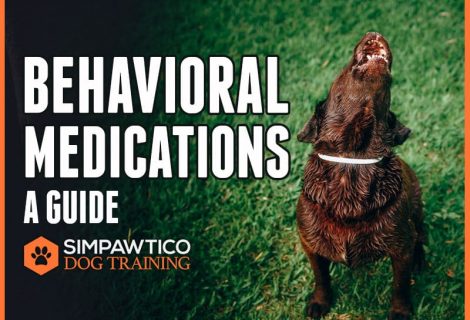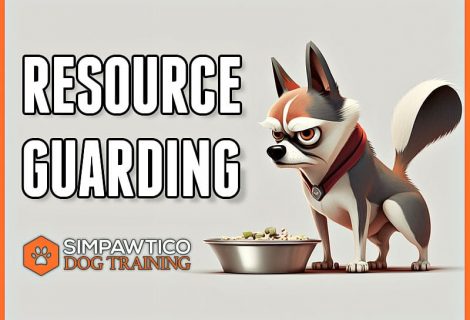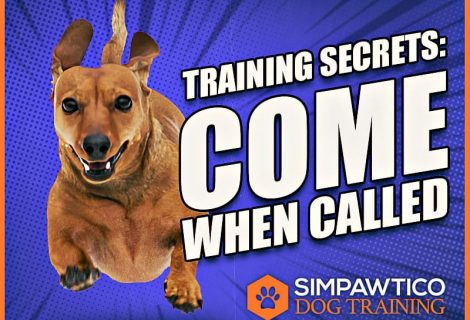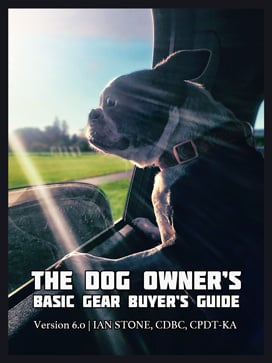How to Use Station Training to Develop Useful Behaviors with Your Dog
A free PDF of this article is available for download!
DOWNLOAD THE PDF (1.8mb)
This post contains affiliate links. These won’t cost you anything, but the commissions we may earn through them help offset the cost of dog treats. Thanks for your support!
Stationing is a wonderfully useful skill for your dog to have. I call it a “Swiss Army Knife behavior” because you can mold it into many applications in different situations. Some things you can do with it include:
- Place or On Your Bed (use for settle down time, when people come over when you need to clean up; super useful when a baby is around)
- Get up onto a chair or furniture on command (try this on a park bench during a walk or hike)
- Get on the scale at the vet (your Vet Techs will thank you for this one)
- Platform training (which we then use for Stay-proofing and independent limb awareness)
- Urban Agility (so we can provide more enrichment out on walks)
Start with a practice platform. This is usually just a stand-in for whatever your end targets will be. Use the bed to start if you’re mainly concerned with teaching an “On Your Bed” command. Otherwise, I like to use the stand in “Climb” because I can turn that into a dozen other things once the motor skills are taught.
A raised platform tends to be better for this kind of work because it makes the platform’s boundaries super obvious to your dog, thus spotlighting the motor skills you’re trying to teach with this activity. The most DIY method is to bang together some plywood and 2x4s. You could also use a raised bed like a Kuranda bed. There are commercially available training platforms such as the Klimb by Blue9 and the Cato board; these are usually spendy. I get the expensive ones for my training studio because we do a lot of platform training; you may only need one for specific activities, so do what’s best for you.
If you have a dog that’s too weirded out by a raised platform, your practice platform could be as simple as a bath mat or a yoga mat. You might even get away with using a large cushion like a dog bed or from the couch.
LURE TRAIN THE BEGINNING
The first training step is to get your dog on the platform and make it fun and dynamic. Generally, you can lure your dog onto the platform with food. You’ll mostly have to let your dog set the pace for this, but if you do it as I describe, you can move pretty quickly through it.
As you might expect, some dogs will be more apt to get on the platform than others. Some will be just baffled by what you want, and others might be a little unsure. Maybe you’ll get all four feet on right away; maybe you’ll only get the front feet on.
In any event, the secret is to explode away from the platform. That is to say, reward your dog AWAY from the platform. I know that may sound counterintuitive, but it is the secret sauce in this activity. When you get to where your dog’s comfortable—whether that’s four feet or two—mark it “Yes!” and explode away from the platform into reward. Have a quick (but good) reward event. And then RUN back to the platform for the next rep.
Get on, get off, get on, get off, get on, get off, and so on. Make it dynamic!
In my experience, even the most unsure dogs enthusiastically jump onto the platform in about 5-10 minutes. Now you’re ready for the next stage.
FADE THE LURE
After the reward event, you’ll notice that your dog is beginning to anticipate getting on the platform, and the lure becomes less and less necessary. As always, fade that lure! Getting rid of the lure is the most important step in Lure-Reward Training. Start motioning without food by pointing to the platform.
At this point, it’s also appropriate to start attaching a verbal prompt. You can use whatever phrase you want that’s appropriate to your end goals. I use “Climb” for my blank platform so that I can still use a different prompt for specific stationing (like, “On Your Bed”). Incidentally, I use “Climb” with my dogs at the vet’s office for the scale or when I want them to hang out on a bench or something. They’ve learned that any raised surface is a platform, which is some awesome generalization I’ve reinforced as it’s manifested!
Whatever your prompt is going to be, make sure to say it first before you move:
Verbal > Signal > Behavior > Mark+Reward
Say your prompt (e.g., “Climb”). Then immediately signal by pointing at the platform. You may temporarily need to take some steps towards the platform, although you should be conscious of phasing this out, too. Your dog will jump on the platform. Mark it (“Yes!” or click) and now explode off and away from the platform into a reward-event.
You should not need the food to get them on the platform. If you still need a tiny little luring, that’s OK. Just be conscious of working through the reps and getting rid of it. In a training session where you’re putting in the reps, you can usually build some behavioral momentum and get rid of a lure by the end of that session.
DURATION
Once a verbal prompt is established, and you’ve faded the lure, move into building duration on the platform. Now, you will delay the explosive reward away from the platform. Instead, you’ll use your duration marker “Good” and drip-feed your dog while they’re on the platform at a rate of about one small piece of food per second. Try to get three seconds and then, as before, mark the end and pop away into the main reward event.
Note: this is almost exactly the duration-building process for teaching formal Stays.
Extend the time your dog spends on the platform from three to five. Then five to eight. Then to ten seconds. Always end in an explosive reward off of and away from the platform. This preserves the fun and dynamic nature of the exercise. It also cultivates a positive emotional response to getting on the platform and waiting through the duration. We also need to set up each new repetition.
PRO TIP: keep your “Good” marker tone and volume neutral. Save your enthusiasm for the ending reward-event.
As you stretch the time, begin spacing each piece of support food farther and farther apart. There’s no reason 10 seconds should equal 10 pieces of food longer than a day or so. Your dog will tell you what they’re ready for. That is to say, if you can whittle it down to one piece of food for the whole thing, SUPER. If they start to get wiggly or bail off the platform, then you need more support for the time being. It’s ok: that’s how training works!
You may also start introducing control positions as part of your duration work. A Sit or a Down is great, depending on your end goals with this. If your work with auto-sits is going well, you’ll probably start getting at least a Sit offered to you without having to ask.
PRO TIP: if you’re prompting the Sit or Down, ensure you’re also conscious of fading that prompt. Getting on the platform for duration should be implied and contained in the whole behavior. Otherwise, you’ll have to feed your dog directions forever. Help them think through it and develop a richer understanding of the expectation.
By the time you reach this point, your dog will be psyched to get on that platform. If I get one of my pro platforms out of storage to work on this my dog, Wednesday, will slap it out of my hands and then jump and sit on it like Thumper from “Bambi,” going, “Look what I can do!”
PROOFING
When your duration reaches 30 or more seconds, you’re ready to start expanding and diversifying this behavior. Here are some suggestions:
If you want a mobile station (for traveling or out and about), start practicing with your travel platform in other places. Be aware you may need to back up and reteach when you change the picture.
If you like a general “Swiss-Army Behavior” as I use with “Climb,” this is where you’ll start introducing it in some of those situations in the world. It’s ok to reintroduce some of the training aids like treats and your body movements as you do these. This is temporary and expected.
If you’re working on an at-home station like “On Your Bed,” start introducing distractions and longer duration. Slowly introduce things that will tempt your dog to break the station. Have lunch on the couch. Have a friend over. Bounce a ball. Have someone ring the doorbell. Drop a potato chip on the floor. Just keep in mind that you’re not trying to sabotage your dog; if they’re making too many mistakes, you’re doing too much. Climb the ladder of difficulty slowly and steadily; it’s not a sprint.
ADD-ONS
Part of the fun here is discovering some of the other things you can do with this skill. Here’s a short list of some of the extended possibilities:
Station training will likely move faster with some reward scaling (a form of differential reinforcement)!
Working with a platform will send Stay practice into the stratosphere. That almost magnetic attachment to the platform makes it so easy to proof Stays that they become bomb-proof. It’s what got me to be able to put one of my dogs in a Sit-Stay at a Soccer game at a local park, drop the leash, walk away to help someone, and then come back several minutes later to a still-perfect Sit-Stay.
You can phase platforms into more mobile things like yoga mats, EVA squares, and even tiny little pads. These are more portable and increase your dog’s skills.
Set up multiple stations—inside or outside—and give each one a different name. My friends doing field trials with their bird dogs do stuff like this all the time to teach directional commands.
You can also use multiple stations to teach Send Away commands.
You can use a “Send Away” station to practice Come commands. Send your dog to a station. Get a short Stay. Recall them.
Do the above exercise with other kinds of Recall variations such as Come-to-Heel, Come-Front, Come-Place (between the legs), and anything else you can imagine. If you have a working breed like a German Shepherd, they LOVE this kind of stuff.
You can use smaller platforms like rubber feeder tubs upside down or flat rubber touch pads to develop a dog’s proprioception, which is their awareness of individual limbs without having to look. We use these to develop hind-end awareness so they learn to pivot around their front legs. We also use this for athletic dogs to increase their deftness and balance. It’s pretty cool stuff.
Stationing can often benefit reactive or aggressive dogs who can develop initial confidence and stability by having an inviolable safe space that always guarantees reinforcement. There are many moving parts to working with any reactivity or aggression, but stationing may be a helpful add-on for this kind of work. Make sure to loop in a certified dog trainer, certified behavioral consultant, or behaviorist whenever you’re working with reactivity or aggression!
Side note: I actually condition many of the dogs I work with to feel the same way about the Heel-Sit position. So, to them, a Heel-Sit by their owner is a safe and protected place where they can always be right. They’ll gravitate to it.
Whatever you do with your stationing work, there are tons of benefits and possibilities. Have fun!
P.S. Don’t forget to DOWNLOAD THE PDF (1.8mb)


